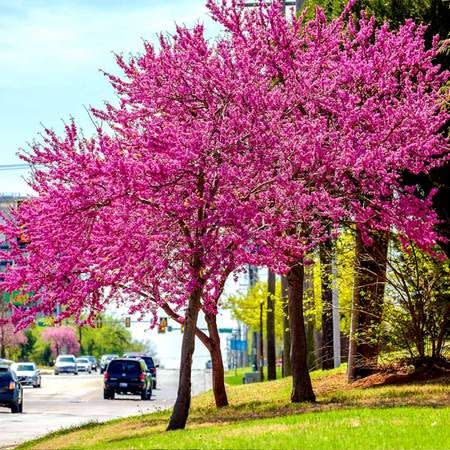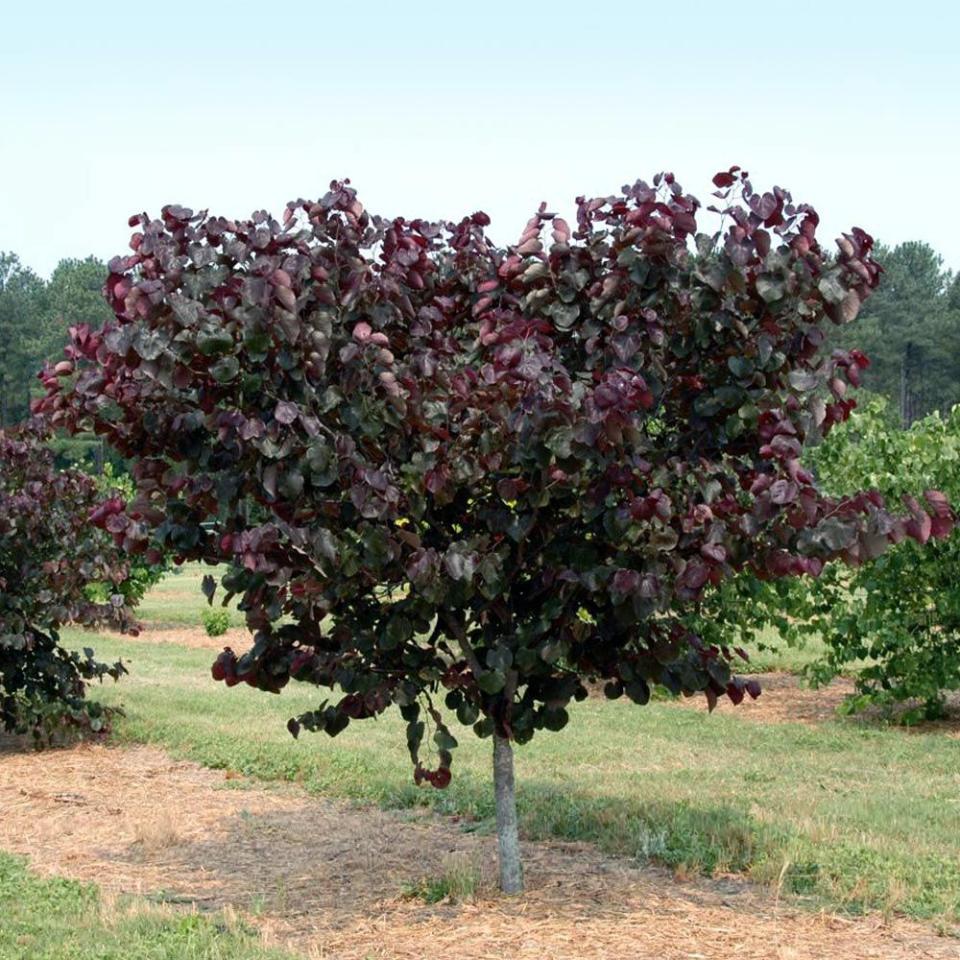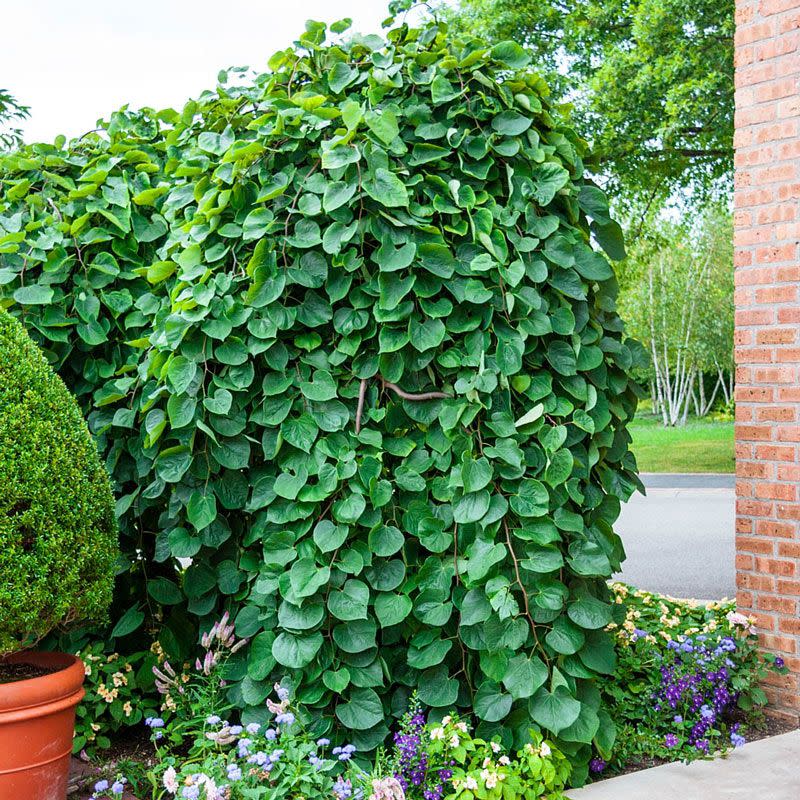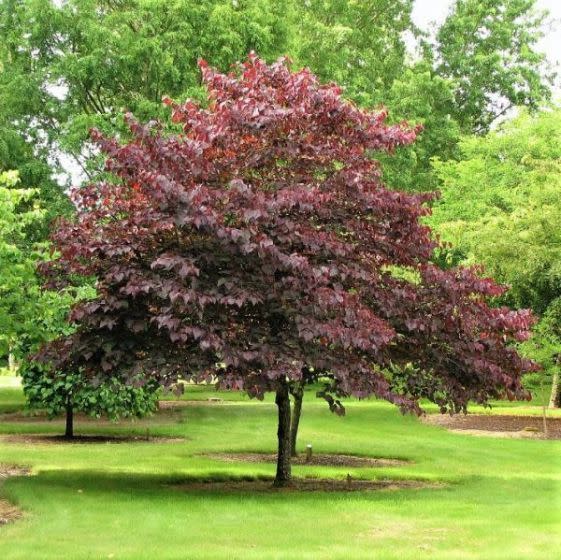Your Guide To Planting and Caring for Beautiful Redbud Trees
"Hearst Magazines and Yahoo may earn commission or revenue on some items through these links."
If you spot lavender-pink flowers clustered on bare tree branches in early spring, you've probably stumbled upon a lovely redbud tree! This flowering tree (just like the mighty magnolia tree), native to woodland areas, has exquisite sweet pea-like flowers that last for weeks before their pretty heart-shaped leaves appear. Pollinators love redbuds because they’re one of the first trees to bloom in early- to mid-spring. They even display bright colors come fall! Best of all, they’re tough little trees that will work in any garden and look beautiful as part of your landscaping ideas. Plus, they always bring a smile to Ree Drummond's face. She absolutely loves them! "If you love purple, the short time when Oklahoma Redbuds are blooming is like being in a dream," she says. So, if you were hoping to learn how to plant redbuds in your own yard, there's good news ahead for you.
"Redbuds are very adaptable," says Nancy Buley, communications director for J. Frank Schmidt & Son, Company, wholesale tree growers in Oregon. “They grow from Massachusetts to Florida and Texas to Minnesota, with more cold-hardy cultivars—or cultivated varieties—having developed in recent years.”
But before you plant one of these gorgeous trees in your own garden, there are a few things you need to know about how to care for a redbud tree! Read on for a total redbud tree guide ahead, including information about redbud varieties, planting tips, maintenance, and more.
What types of redbud trees are there?
There are many different varieties of redbud trees, so make sure you choose one that's suited for winters in your USDA hardiness zone. You can buy online or at a local nursery, where you’ll find both single trunk and multi-stem varieties, the latter of which have a shrubbier appearance.

Here are a few outstanding types of redbud trees you might want to check out:
Appalachian Red Redbud Trees: Show off bright rosy-red flowers.
Oklahoma Redbud Trees: Have pink flowers and then glossy green leaves.
Merlot Redbud Trees: Boast pink flowers that turn into wine-red foliage later.
Flame Thrower Redbud Trees: Have pink flowers and red foliage that fades to yellow and green.
Lavender Twist Redbud Trees: A weeping variety with pink flowers.
Where is the best place to plant a redbud tree?
Before you start digging, you'll want to pick the perfect place for your new redbud tree to bloom. Keep in mind that redbud trees are considered moderate growers which means they can reach about ten feet in five to six years. When all is said and done, most varieties will grow about 20 feet tall by 25 feet wide, so make sure your tree will have plenty of room to spread its branches out. That being said, you'll want to keep a minimum of six to eight feet between any structures and your chosen planting site as well as a a minimum of three feet from fences. Be sure to watch out for low rooflines or wires before planting, too.
While redbuds can easily survive in most climates, you still want to make sure you're giving them everything they need to thrive. You should find a spot with complete sun or partial shade as the ideal exposure for this tree is six to eight hours of full sunlight per day. Note: This can also determine the shape of your tree. The redbud will look fuller and more compact in the sun whereas the shade will cause a more arching shape as it reaches for the light. As for the soil type, redbuds are very pH adaptable and will do well in both alkaline or acidic soil as long as its moist and well-drained.
How do I plant redbud trees?
Once it's time to put your new redbud in the spot you've chosen, here's what you'll need to do: Dig a hole about two- to three-times as wide as the container it came in.

Stainless Steel Shovel
amazon.com
$68.74
AmazonDon’t add anything such as peat moss or potting soil to the hole. This old-school planting practice is no longer recommended because studies have shown that it may cause drainage problems and encourage the roots to stay in the hole instead of spreading out into the surrounding soil. Ultimately, your plant has to grow in its native soil so it can be nice and strong.
Next, gently tip the tree out of its container—or remove burlap, twine, or wires if it’s a balled and burlapped tree (burlap won’t biodegrade quickly so you have to remove it). Use your hand to rough up the surface of the root ball or use a pruner to snip any tree roots that are circling around it. This part necessary as it stimulates the roots to grow, says Buley.
Finally, you'll want to place your tree in the hole at the same height it was in the container. “The biggest mistake is planting too deep,” says Buley. “Make sure the tree’s root flare, where the base widens slightly, is above ground.” Refill the hole with soil, gently tamp down, and water it well.
How do I care for redbud trees?
Help your tree get established by watering it deeply for the first few years, especially during droughts. Most new trees need about 15 gallons a week! “It’s better to water deeply and infrequently than give it a daily squirt because that encourages roots to stay near the surface,” says Buley.
It’s also a good idea to add a two- to three-inch deep layer of mulch around the base to retain moisture and keep down weeds. However, you'll need to pull the mulch away from the tree trunk and spread it so it looks more like a donut, rather than a volcano. “Volcano mulching,” or mulch placed right up against the trunk, encourages decay and could invite pests and disease.
You'll be pleased to hear that pruning isn’t necessary for a redbud tree because it keeps its shapely form naturally. That being said, it’s fine to trim off any broken or crossing branches. Otherwise, all you have to do is enjoy this beautiful springtime bloomer!
Oklahoma Redbud

Oklahoma Redbud
fast-growing-trees.com
$179.95
Merlot Redbud Tree

Merlot Redbud Tree
brighterblooms.com
$109.99
Merlot Redbud Tree

Merlot Redbud Tree
thetreecenter.com
$159.50
The Tree CenterLavender Twist

Lavender Twist
springhillnursery.com
$79.99
Forest Pansy Redbud

Forest Pansy Redbud
naturehills.com
$79.95
You Might Also Like

